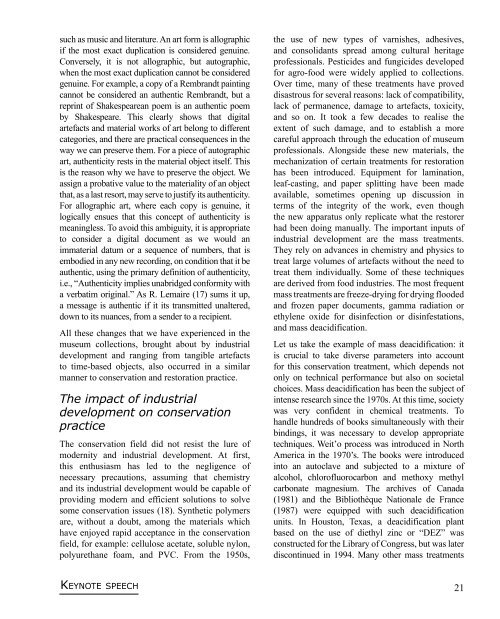dk nkf - Nordisk Konservatorforbund Danmark
dk nkf - Nordisk Konservatorforbund Danmark
dk nkf - Nordisk Konservatorforbund Danmark
Create successful ePaper yourself
Turn your PDF publications into a flip-book with our unique Google optimized e-Paper software.
such as music and literature. An art form is allographic<br />
if the most exact duplication is considered genuine.<br />
Conversely, it is not allographic, but autographic,<br />
when the most exact duplication cannot be considered<br />
genuine. For example, a copy of a Rembrandt painting<br />
cannot be considered an authentic Rembrandt, but a<br />
reprint of Shakespearean poem is an authentic poem<br />
by Shakespeare. This clearly shows that digital<br />
artefacts and material works of art belong to different<br />
categories, and there are practical consequences in the<br />
way we can preserve them. For a piece of autographic<br />
art, authenticity rests in the material object itself. This<br />
is the reason why we have to preserve the object. We<br />
assign a probative value to the materiality of an object<br />
that, as a last resort, may serve to justify its authenticity.<br />
For allographic art, where each copy is genuine, it<br />
logically ensues that this concept of authenticity is<br />
meaningless. To avoid this ambiguity, it is appropriate<br />
to consider a digital document as we would an<br />
immaterial datum or a sequence of numbers, that is<br />
embodied in any new recording, on condition that it be<br />
authentic, using the primary definition of authenticity,<br />
i.e., “Authenticity implies unabridged conformity with<br />
a verbatim original.” As R. Lemaire (17) sums it up,<br />
a message is authentic if it its transmitted unaltered,<br />
down to its nuances, from a sender to a recipient.<br />
All these changes that we have experienced in the<br />
museum collections, brought about by industrial<br />
development and ranging from tangible artefacts<br />
to time-based objects, also occurred in a similar<br />
manner to conservation and restoration practice.<br />
The impact of industrial<br />
development on conservation<br />
practice<br />
The conservation field did not resist the lure of<br />
modernity and industrial development. At first,<br />
this enthusiasm has led to the negligence of<br />
necessary precautions, assuming that chemistry<br />
and its industrial development would be capable of<br />
providing modern and efficient solutions to solve<br />
some conservation issues (18). Synthetic polymers<br />
are, without a doubt, among the materials which<br />
have enjoyed rapid acceptance in the conservation<br />
field, for example: cellulose acetate, soluble nylon,<br />
polyurethane foam, and PVC. From the 1950s,<br />
Keynote speech<br />
the use of new types of varnishes, adhesives,<br />
and consolidants spread among cultural heritage<br />
professionals. Pesticides and fungicides developed<br />
for agro-food were widely applied to collections.<br />
Over time, many of these treatments have proved<br />
disastrous for several reasons: lack of compatibility,<br />
lack of permanence, damage to artefacts, toxicity,<br />
and so on. It took a few decades to realise the<br />
extent of such damage, and to establish a more<br />
careful approach through the education of museum<br />
professionals. Alongside these new materials, the<br />
mechanization of certain treatments for restoration<br />
has been introduced. Equipment for lamination,<br />
leaf-casting, and paper splitting have been made<br />
available, sometimes opening up discussion in<br />
terms of the integrity of the work, even though<br />
the new apparatus only replicate what the restorer<br />
had been doing manually. The important inputs of<br />
industrial development are the mass treatments.<br />
They rely on advances in chemistry and physics to<br />
treat large volumes of artefacts without the need to<br />
treat them individually. Some of these techniques<br />
are derived from food industries. The most frequent<br />
mass treatments are freeze-drying for drying flooded<br />
and frozen paper documents, gamma radiation or<br />
ethylene oxide for disinfection or disinfestations,<br />
and mass deacidification.<br />
Let us take the example of mass deacidification: it<br />
is crucial to take diverse parameters into account<br />
for this conservation treatment, which depends not<br />
only on technical performance but also on societal<br />
choices. Mass deacidification has been the subject of<br />
intense research since the 1970s. At this time, society<br />
was very confident in chemical treatments. To<br />
handle hundreds of books simultaneously with their<br />
bindings, it was necessary to develop appropriate<br />
techniques. Weit’o process was introduced in North<br />
America in the 1970’s. The books were introduced<br />
into an autoclave and subjected to a mixture of<br />
alcohol, chlorofluorocarbon and methoxy methyl<br />
carbonate magnesium. The archives of Canada<br />
(1981) and the Bibliothèque Nationale de France<br />
(1987) were equipped with such deacidification<br />
units. In Houston, Texas, a deacidification plant<br />
based on the use of diethyl zinc or “DEZ” was<br />
constructed for the Library of Congress, but was later<br />
discontinued in 1994. Many other mass treatments<br />
21

















